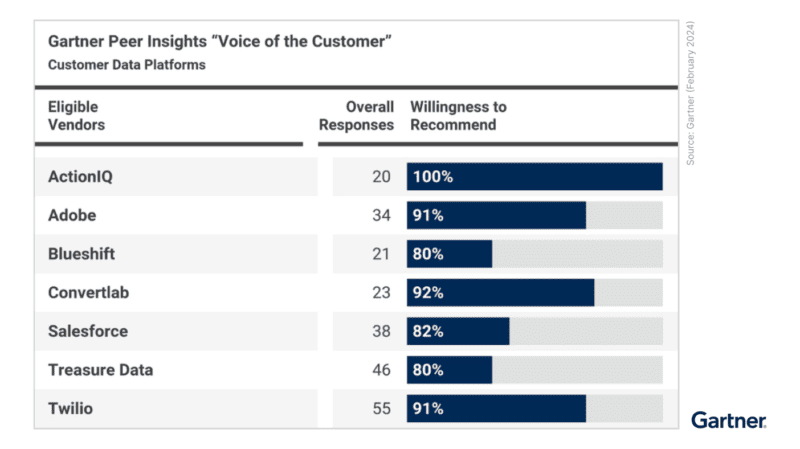How Enterprise Brands Can Simplify the CDP Market

Sometimes billion-dollar ideas start small. Look no further than the customer data platform (CDP) market for proof.
Seen as an emerging technology not too long ago, now nearly 90% of brands say they’ve either already deployed a CDP or are planning to.
But what started as a straightforward technology proposition has gotten more complicated. A glut of vendors — each claiming their products are superior — have created a crowded and confusing landscape for buyers.
The CDP market shows no signs of slowing down — 20 new vendors entered the space during the first half of 2021 alone — but there is a way to cut through the noise.
How Enterprise Brands Can Simplify the CDP Market
The secret? Looking past the flashy advertising to focus on core outcomes.
For instance, Autodesk wanted to orchestrate personalized customer journeys to support its subscription-based business. Find out more in the video below:
Learn the 2 Ws of CDP Success
It’s easy to get bogged down by the bells and whistles when shopping for an enterprise CDP.
Two questions should be top of mind when you’re evaluating your options (we call them the 2 Ws):
- What problem was it built to solve?
- Who was it designed to be used by?
When you understand the original purpose of a technology — and who its primary users were intended to be — you can avoid shiny object syndrome and concentrate on business value.
At the end of the day, CDPs fall into one of three buckets based on their primary use cases:
- Consolidating siloed customer profiles
- Modeling and predicting customer behaviors
- Orchestrating personalized customer experiences
Every CDP should have some capacity for unifying, analyzing and activating customer data, but each type will specialize in one of these areas.
For example, both the Adobe CDP and Salesforce CDP were intended to compile data from point solutions within their cloud portfolios to create a single view of the customer. Meanwhile, the Segment CDP was designed to collect event data from digital applications and transmit it to other apps for integration and triggered communication purposes. Each technology is different, but they all fall under the banner of data consolidation CDPs.
Once you know the “what,” you can identify the “who.” Different types of CDPs are aimed at specific teams: technical, analytics or business.
So ask yourself:
- Are you shopping for IT users? (They may prefer a composable CDP.)
- Are you looking to give your data scientists a leg up?
- Or do you want to enable your marketing, sales and customer service teams?
See how Condé Nast achieved a 95% lift in conversion rate by empowering its paid advertising team with customer data in the below video:
Prioritize End Results
Forty-two percent of organizations that have deployed a CDP are living every buying committee’s worst nightmare: Their choice is delivering little or no value.
The root cause isn’t a mystery. It’s long been established: The No. 1 reason CDP deployments fail is either not having solid use cases in mind or overcomplicating the ones you have.
Even if you understand what different technologies are built to do and who they’re designed to help, it makes no difference if it doesn’t align with your business objective.
Is your end goal collecting and analyzing data? Or do you want to operationalize that data into compelling customer experiences?
Before you wade into the murky CDP marketplace, make sure you know what you’re trying to accomplish.
Albertsons Companies wanted to become more customer-centric with its CDP. Hear the brand’s story below:
Understand the Stakes
Enterprise brands are facing no shortage of headwinds.
Expectations for highly relevant, impactful customer experiences continue to rise: 75% percent of consumers say they’ll pay more for solid CX, and 50% say they’ll switch to a competitor after a single negative experience.
Meanwhile, the data many companies relied on to fuel personalized customer engagement is disappearing. Third-party cookie deprecation means brands must master a whole new marketing playbook — one powered by authenticated first-party data.
Whether to deliver exceptional CX in real time or to overcome the death of the cookie, brands are turning to CDPs in droves.
But the stakes have never been higher — brands can’t afford to make the wrong choice. Enterprise-grade scalability, flexibility and connectivity are all essential.
As you navigate the complex CDP market, remember this: What matters most is the destination you’re trying to reach — and empowering the people who will get you there.
Learn More About the CDP Market
Download the CDP Market Guide to understand your options and decide which solution best suits your business needs.
Ready to speak to an expert? Get a demo of ActionIQ.





